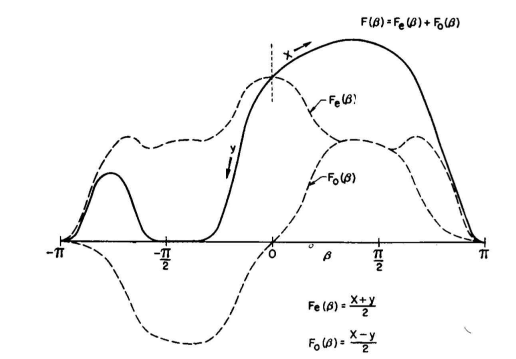| Radio Antenna Engineering is a free introductory textbook on radio antennas and their applications. See the editorial for more information.... |

|

Home  Medium-frequency Broadcast Antennas Medium-frequency Broadcast Antennas  Directive Antennas Directive Antennas  Synthesis of any Azimuthal Pattern Synthesis of any Azimuthal Pattern |
||||






|
||||
|
Synthesis of an Array for Any Specified Azimuthal PatternAuthor: Edmund A. Laport
Wolf described a method of synthesizing an array for any arbitrary symmetrical pattern using the principles of complex Fourier analysis.
The present method utilizes the method of Wolf in the course of its development. Any radiation pattern F(β) in the equatorial plane of a multiplicity of parallel identical linear radiators is periodic in 2 π and can therefore be treated with the general methods of Fourier analysis. Any arbitrary pattern may be classed as even and symmetric if F(β) = F(-β), as odd and symmetric if F(β) = -F(-β), or as uneven (asymmetric) if in nonconformance with both of the foregoing. An even function can be obtained from a linear broadside array with symmetrical Fourier current distributions. An odd function can be obtained from a linear end-fire array with a symmetric but inverted Fourier current distribution. An uneven function can be obtained by the combination of the even and the odd functions. Let F(β) in Fig. 2.50 represent a prescribed azimuthal radiation pattern for a particular application in the domain from -π to +π. This is shown to be an uneven function with respect to the reference azimuth β = 0. If we designate the function between 0 and +π as X and that between 0 and -π as Y, it can be demonstrated that the even and odd components of this uneven function are
and
and also that Fe(β) + F0(β) = F(β). The even and the odd components of F(β) are shown dotted in Fig. 2.50. It is therefore obvious that since we have means for generating any desired even radiation function and also any desired odd radiation function, we can apply this method and obtain means for exactly generating any arbitrary asymmetric radiation pattern.
obtain means for exactly generating any arbitrary asymmetric radiation pattern. The application of Wolf's method is straightforward mathematically, though it remains for the engineer using it to decide on the minimum number of terms in the Fourier series that will give a satisfactory approximation to the desired result. By adding terms, which means adding pairs of radiators, one can approach the desired result as closely as economic considerations will permit.
The Fourier array, while it always provides a theoretical solution, frequently does not provide a practical or economical solution for an asymmetric pattern problem. One must then resort to the use of random, or nonsystematic, arrays. There are no known systematic methods for synthesizing such arrays except trial and error, reference charts of patterns for nonsystematic arrays of three
|
||||
Home  Medium-frequency Broadcast Antennas Medium-frequency Broadcast Antennas  Directive Antennas Directive Antennas  Synthesis of any Azimuthal Pattern Synthesis of any Azimuthal Pattern |
||||
Last Update: 2011-03-19





